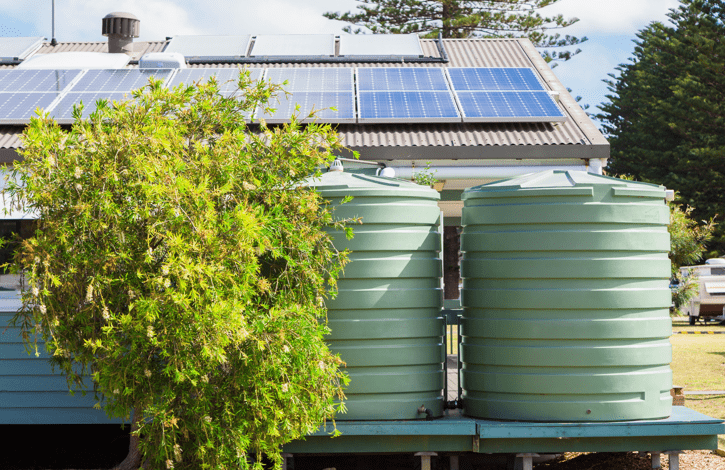Water Storage Tanks: A Sustainable Homeowner’s Buying Guide

Your household water consumption can skyrocket because of loads of washing tasks such as dishwashing and laundry. This can hurt your budget because most homeowners source water from the municipal water system. And as such, one sustainable or ‘green’ solution to reduce high water utility bills and preserve water is investing in a water storage tank.
But how do water storage tanks work? Rainwater tanks generally have an overflow mechanism, collecting stormwater from roofs and other impervious surfaces. And aside from giving you easy access to water whenever you need it, water storage tanks can also help decrease the amount of rainwater that enters stormwater drainage systems and waterways.
In this article, you’ll learn how water storage tanks can help you save money and practice a more sustainable way of storing and using water.
The Sustainability Of Water Storage Tanks

Excessive stormwater can overflow the waterways and drainage systems, which leads to flooding. And as mentioned earlier, water tanks can help prevent this. Homeowners can utilize water storage tanks to catch and collect stormwater that can be used for house chores such as washing the dishes, cleaning, laundry, watering the plants, and flushing the toilets.
Conventional water storage tanks typically have 1,000 to 5000 liters of water loading capacity. But for this purpose, using bigger tanks is highly advisable, like this larger tank that can hold up to 30,000 liters of rainwater, equivalent to 1,133 loads of washing.
Important Factors To Consider
Aside from the water storage tank capacity, there are various factors you should keep in mind when choosing one for your home. To name a few, consider the following:
-
Material Quality
The material of a water storage tank reflects its quality and is more likely to determine how long it’ll remain functional. Sustainable water tanks are generally made from food-grade polyethylene, complying with the water storage standards. They are also BPA-free. Other tank materials include fiberglass, known for its durability, ease of installation, and corrosion resistance properties.
Choosing a durable and quality material can be costly at first, but it can be a worthwhile investment, considering its benefits.
-
Water Storage Tank Supplier
When buying a water tank storage, the supplier or vendor you’ll be purchasing it from also matter. Aside from the quality of the tank storage, buying from a trusted and reputable supplier can also provide you with a guarantee, outfitting service, and friendly customer service.
When choosing the best supplier, compare the vendor’s offering in terms of pricing, water harvesting capacity, the tanks’ material and design, and more importantly, their tank repair or replacement warranty policies.
-
The Available Space In Your Property
Another essential thing you have to factor in when getting a water storage tank is the space on your property. Remember, the higher your water tank’s harvesting capacity is, the more space you’ll need to accommodate it. And that could only be possible if you have ample space at home to place your tank.
Also, some water tanks can be installed underground if you don’t prefer them to be seen or take up much space in your backyard or garden.
-
Local Rules And Regulations
You should also find out the water supply rules in your area in terms of the type of acceptable water tank, the manner of collecting rainwater, and how to prevent water tanks from being mosquito breeding places. In that way, you can be assured that you’re not violating any law or regulations which may require you to pay fines and penalties.
-
The Tank’s Aesthetic Appeal
Sustainable water storage tanks come in various colors, such as white, mist green, beige, and charcoal, to match your home’s design and property’s theme.
If you’re opting for an underground water tank, then the tank’s aesthetic and color wouldn’t matter much. However, if you’ll be going for above-ground tanks, then this tip can be applicable to you.
Installing A Water Storage Tank
Proper water storage tank installation is crucial to its longevity and function. The two water tank installation methods include above the ground and underground. Regardless of the installation method and tank, building a concrete foundation or base where the water tank will stand is advisable to secure it. It can also help promote easier tank maintenance and preserve its lifespan.
You’ll need to dig the ground for underground tank installation before creating a base. The excavation hole should be larger than the base.
Maintaining A Water Storage Tank
Algae carry bacteria and can affect not only your water storage tank’s lifespan but also the quality of water it’ll be dispensing. And as such, proper and regular maintenance of your water tanks can help prevent algae formation, giving your household potable and clean water.
Using bleach or chorine is also believed to help kill algae. But it’s essential to determine the right ratio of bleach and water or chlorine and water. This is because chemicals may affect the potability, taste, and quality of water.
Ideally, maintain and clean your storage tank at least once a year. You can do this task by yourself. You can also call a water tank cleaning service provider to assist you.
Conclusion
Homeowners can greatly benefit from using sustainable water tanks. However, there are important things to consider before choosing one. In addition, purchasing a sustainable water tank doesn’t stop there. Homeowners also need to ensure that their tanks are kept clean and comply with municipal regulations.




